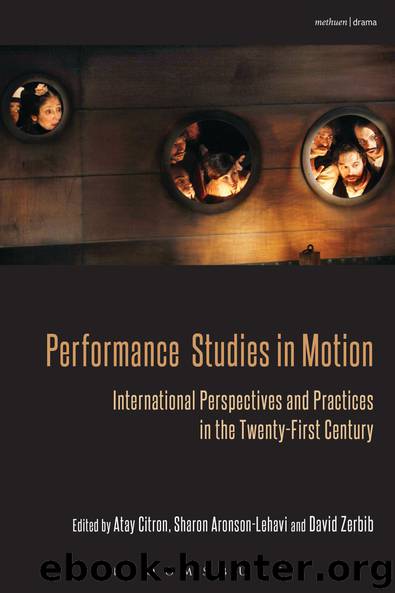Performance Studies in Motion by Citron Atay; Aronson-Lehavi Sharon; Zerbib David

Author:Citron, Atay; Aronson-Lehavi, Sharon; Zerbib, David [Неизв.]
Language: eng
Format: epub
Publisher: Bloomsbury Publishing
Figure 12 With IDF soldiers becoming spect-actors, ‘Tul Karem-Tel Aviv Theatre Group’ is performing near the village of Izbat-Tabib in 2013. Photo by Combatants for Peace.
Site-specific invisible theatre and the vision of a utopian space
Boal’s first book briefly recounts the Invisible Theatre technique,12 and his second book, Games for Actors and Non-Actors, surveys its technical development in depth.13 Essentially it consists of the covert mounting of a piece of provocative theatre in a public place, so as to cause discussion and debate among unknowing ‘spect-actors’.14 Boal emphasizes that Invisible Theatre is first and foremost theatre: it is perceived as a play, including actors who play characters and a prearranged text. The chosen subjects for invisible theatre are of utmost importance to the actors and spect-actors. Invisible Theatre is only staged in public spaces that are not defined as theatre spaces, and only to an audience that does not know that it is an audience.15 ‘Invisible theatre is not realism, it is reality.’16
In conventional theatre, the consent of the audience and theatre-makers is that the architecture can add and remove meaning in accordance with the needs of the play. The same space can be a fifteenth-century open field or an American kitchen in the 1950s.
In activist theatre, the space is a dimension in itself,17 and in the polarized model, it is sometimes even the decisive element.
Site-specific theatre is usually dependent on the given space defined by the architecture.18 In the case of a performative resistance group, site-specific theatre actually depends on the political context, as place is not merely architectural space but also charged with the political significances of the system of power relations that functions on and in it. With an intimate performative process, it often becomes a utopian space, enabling one to experience and imagine a place in which external power relations are cancelled and no longer exist.19 However, in such cases, neutralizing the power relations from actual reality and leading to their apparent disappearance effectively reaffirms their presence.
The concrete embodiment of polarization in space facilitates mobility and transformation of the individual, the single-nation group and the polarized plenary group. The possibility of imagining and then embodying crossing borders between polarized spaces within the framework of theatrical exercises – in which one can cross the imaginary ‘line’ and appear next to or inside the opposite group – is charged with performative utopian potential.20
Boal contends that the non-violent performative act constitutes trespassing.21 The fact that non-actors create a theatrical space for themselves challenges the accepted perceptions of ‘who is allowed where’. This is a fundamental principle of the main technique of the Theatre of the Oppressed, Forum Theatre. Its ethics and aesthetics require and transgress an additional border, as it enables the oppressed (the spectators) to go on stage and replace those who have already trespassed (the protagonist/s).
The choice of a liminal space, between two areas – between two roadblocks that separate Area A and Area B,22 when it is unclear whether we are in Area B or C and
Download
This site does not store any files on its server. We only index and link to content provided by other sites. Please contact the content providers to delete copyright contents if any and email us, we'll remove relevant links or contents immediately.
Aircraft Design of WWII: A Sketchbook by Lockheed Aircraft Corporation(32137)
The Great Music City by Andrea Baker(30781)
Call Me by Your Name by André Aciman(19904)
The Art of Boudoir Photography: How to Create Stunning Photographs of Women by Christa Meola(18408)
The Secret History by Donna Tartt(18163)
Shoot Sexy by Ryan Armbrust(17557)
Plagued by Fire by Paul Hendrickson(17111)
Portrait Mastery in Black & White: Learn the Signature Style of a Legendary Photographer by Tim Kelly(16872)
Adobe Camera Raw For Digital Photographers Only by Rob Sheppard(16797)
Photographically Speaking: A Deeper Look at Creating Stronger Images (Eva Spring's Library) by David duChemin(16498)
Ready Player One by Cline Ernest(13992)
Pimp by Iceberg Slim(13779)
Bombshells: Glamour Girls of a Lifetime by Sullivan Steve(13685)
The Goal (Off-Campus #4) by Elle Kennedy(13200)
Art Nude Photography Explained: How to Photograph and Understand Great Art Nude Images by Simon Walden(12852)
Kathy Andrews Collection by Kathy Andrews(11326)
The Priory of the Orange Tree by Samantha Shannon(8614)
Thirteen Reasons Why by Jay Asher(8452)
The remains of the day by Kazuo Ishiguro(8395)
